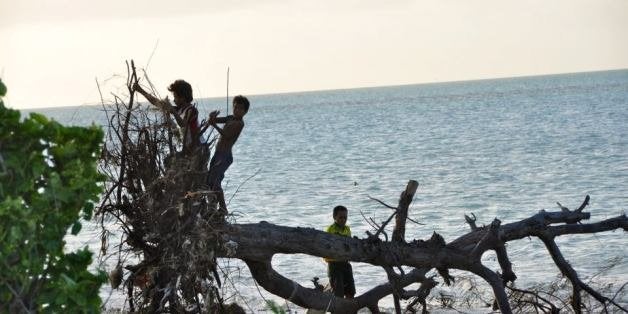
For the peoples of the Pacific, climate change is a pressing reality and a matter of survival.
Our Pacific-island region contributes less than 0.03 percent of the world's greenhouse-gas emissions, yet we are amongst the first to feel the impacts of climate change -- we are on the frontline.
The Pacific ocean is vast -- covering nearly one-third of the earth's surface -- and it is vulnerable. Our region has more than 33,000 islands and is home to a diverse range of peoples, whose lifestyles have adapted to their environment over millennia. Climate change represents a new and existential threat to our region.
We have four of the six lowest countries and territories on Earth -- Tuvalu, Kiribati, Republic of the Marshall Islands and Tokelau -- with the highest point in each country between three to four metres.
Predictions from the IPCC of sea-level rise of up to one metre by 2,100 -- if a "business as usual approach" is taken to carbon emissions -- spell disaster for our region and our peoples.
As Pacific islanders watch their homes being battered by waves, possessions washed out to sea or witness their root crops dying from salt-water inundation, the general feeling is one of injustice, and that we are paying for damage others have brought about.
Of course, it is not just humans who are impacted by climate change -- changing currents, warming seas and ocean acidification are causing fundamental impacts in our Pacific Ocean environment -- the major source of our livelihoods and a rich resource to the world.
For example, in warmer-sand temperatures, turtle eggs are likely to hatch out as fewer males and more females, but they will also die if the sand becomes too hot.
Corals can tolerate only a small degree of warming before they bleach and die, destroying one of the world's most productive ecosystems. Ocean acidification poses an additional threat to the survival of corals, fish and shellfish. We foresee greater declines in the resilience and productivity of the coral-reef structures that surround our islands, protect us and sustain our communities.
That is the reason why many Pacific-island countries have been so insistent that global warming must be limited to no more than 1.5 degrees Celsius above pre-industrial levels.
In the spirit of our ancestral Pacific voyagers, who once travelled across our ocean in search of new lands to settle in, we have already taken action to adapt to the impacts of climate change.
Our Pacific islands are adapting to climate change through practical programmes, such as the Pacific Adaptation to Climate Change (PACC) Project, which has worked in a number of Pacific countries to: improve water security and conservation; improve food security, including through the use of more salt-tolerant agricultural species; and to ensure better protection of the coastal zone.
Pacific-island countries have adopted some of the most ambitious renewable-energy targets in the world, and are now working with partners to achieve these goals.
SPREP has partnered with the World Meteorological Organization, the Government of Finland and Pacific Meteorological Services to better use and apply weather and climate information and develop early-warning systems to better respond to natural disasters.
We have learnt that investing in the protection and management of nature and natural systems -- such as through protecting coastal-mangrove forests -- is a key strategy in responding to climate change.
As this article is being written, Pacific Island peoples' are being impacted directly and deeply by climate change.
Though our practical actions are making a positive difference, their impact will be limited unless global carbon emissions are reduced...
Pacific leaders are thus calling on all countries of the world to agree to a legally binding agreement, with the strongest-possible emission targets, at the Paris climate-convention meeting in December this year.
There is a saying from our region: "If you want to go fast, you go alone, but if you want to go far, you go together."
If we are to address the adverse impacts of climate change, we must all -- at national, regional and international levels, go together. But also go fast, as time is of the essence.
This post is part of a series produced by The Huffington Post, "What's Working: Sustainable Development Goals," in conjunction with the United Nations' Sustainable Development Goals (SDGs). The proposed set of milestones will be the subject of discussion at the UN General Assembly meeting on Sept. 25-27, 2015 in New York. The goals, which will replace the UN's Millennium Development Goals (2000-2015), cover 17 key areas of development -- including poverty, hunger, health, education, and gender equality, among many others. As part of The Huffington Post's commitment to solutions-oriented journalism, this What's Working SDG blog series has focused on one goal every weekday in September. This post, published on the day the conference is scheduled to start, addresses all the Goals.